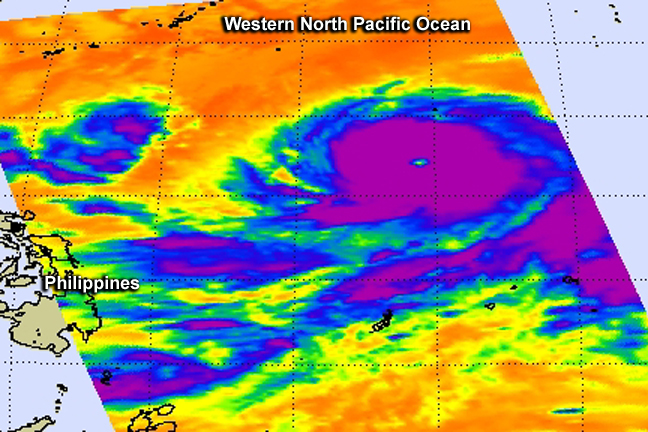NASA Eyes Super typhoon Vongfong

NASA's Aqua satellite gathered infrared data on Super typhoon Vongfong on Oct. 7 at 0429 UTC (12:29 a.m. EDT) reading cloud top temperatures. Strongest storms, coldest cloud tops appear in (purple). Image Credit: NASA JPL, Ed Olsen
On Oct. 7 at 0429 UTC (12:29 a.m. EDT) the Atmospheric Infrared Sounder called AIRS that flies aboard NASA's Aqua satellite captured cloud top temperature data on Super typhoon Vongfong.
AIRS data very strong thunderstorms circling Vongfong's clear 27 nautical-mile wide eye. Those cloud top temperatures were colder than -62F/-53C indicating that they were high in the troposphere and capable of generating heavy rainfall.
The bands of thunderstorms circling Vongfong appeared symmetric on satellite imagery.
At 11 a.m. EDT on Oct. 7, Vongfong's maximum sustained winds were near 135 knots (155.4 mph/250 kph) making it a strong Category 4 Typhoon on the Saffir-Simpson hurricane scale.
Vongfong's center was located near latitude 17.5 north and longitude 133.6 east. That's about 649 nautical miles (747 miles/1,202 km) southeast of Kadena Air Base, Okinawa, Japan. Vongfong is moving toward the west at 11 knots (12.6 mph/ 20.3 kph)
Vongfong is creating massive ocean swells with seas to 47 feet (14.3 meters), according to the Joint Typhoon Warning Center (JTWC).
JTWC forecasters expect Vongfong to continue tracking to the west until it runs into a trough or elongated area of low pressure sometime on Oct. 9 that will turn it to the north.
By Oct. 12, the JWTC expects the center of Vongfong to be near the Japanese island of Amami Oshima. Kadena Air Base and Amami Oshima should prepare for typhoon conditions.
Rob Gutro
NASA's Goddard Space Flight Center
Media Contact
All latest news from the category: Physics and Astronomy
This area deals with the fundamental laws and building blocks of nature and how they interact, the properties and the behavior of matter, and research into space and time and their structures.
innovations-report provides in-depth reports and articles on subjects such as astrophysics, laser technologies, nuclear, quantum, particle and solid-state physics, nanotechnologies, planetary research and findings (Mars, Venus) and developments related to the Hubble Telescope.
Newest articles

Properties of new materials for microchips
… can now be measured well. Reseachers of Delft University of Technology demonstrated measuring performance properties of ultrathin silicon membranes. Making ever smaller and more powerful chips requires new ultrathin…

Floating solar’s potential
… to support sustainable development by addressing climate, water, and energy goals holistically. A new study published this week in Nature Energy raises the potential for floating solar photovoltaics (FPV)…

Skyrmions move at record speeds
… a step towards the computing of the future. An international research team led by scientists from the CNRS1 has discovered that the magnetic nanobubbles2 known as skyrmions can be…





















